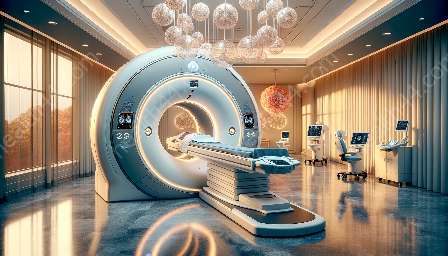Nuclear medicine equipment plays a crucial role in the field of medical imaging and healthcare, offering innovative solutions to diagnose and treat various medical conditions. This topic cluster explores the significance of nuclear medicine equipment, its compatibility with medical imaging devices and medical devices & equipment, and the latest advancements in this dynamic field.
The Role of Nuclear Medicine Equipment in Healthcare
Nuclear medicine equipment encompasses a wide range of tools and technologies used to perform diagnostic and therapeutic procedures by utilizing radioactive substances. These substances are introduced into the body to visualize and treat diseases at the molecular and cellular levels. The use of nuclear medicine equipment has become integral to modern healthcare, offering non-invasive and highly detailed insights into complex medical conditions.
Nuclear medicine procedures assist healthcare professionals in diagnosing and monitoring conditions such as cancer, heart disease, neurological disorders, and more. Furthermore, the equipment enables precise treatment delivery, contributing to improved patient outcomes and enhanced quality of care.
Compatibility with Medical Imaging Devices
In the realm of medical imaging, nuclear medicine equipment complements and expands the capabilities of traditional imaging modalities such as X-ray, MRI, and CT scans. Unlike other imaging techniques that focus on anatomical structures, nuclear medicine imaging provides functional and metabolic information about the body's organs and tissues.
Integration of nuclear medicine equipment with medical imaging devices allows for comprehensive assessments of various diseases and conditions, leading to more accurate diagnoses and personalized treatment plans. This synergistic approach enhances the diagnostic precision and therapeutic effectiveness, empowering healthcare providers to deliver targeted care tailored to each patient's unique needs.
Advancements in Nuclear Medicine Equipment
The field of nuclear medicine equipment continues to evolve rapidly, fueled by technological innovations and research breakthroughs. Cutting-edge developments in radionuclide production, detector technology, and image processing are revolutionizing the capabilities and performance of nuclear medicine tools.
Furthermore, the integration of artificial intelligence and machine learning algorithms is enhancing the speed and accuracy of nuclear medicine imaging and analysis, paving the way for more precise diagnoses and prognoses. These advancements not only elevate the efficiency of nuclear medicine equipment but also drive its broader applicability across a diverse range of medical specialties.
The Future of Nuclear Medicine Equipment
As healthcare continues to embrace personalized medicine and targeted therapies, the demand for advanced nuclear medicine equipment will rise. The future holds the promise of even more sophisticated tools that offer improved resolution, reduced radiation exposure, and enhanced patient comfort during imaging procedures.
Moreover, the convergence of nuclear medicine with molecular imaging techniques and theranostics is poised to create new avenues for tailored treatment strategies, bolstering the role of nuclear medicine equipment in delivering precise and effective healthcare interventions.
Innovations in Nuclear Medicine Equipment
Recent innovations in nuclear medicine equipment include the development of hybrid imaging systems that combine nuclear imaging with other modalities such as PET/CT and SPECT/CT. These integrated systems provide multifaceted diagnostic capabilities, enabling clinicians to correlate anatomical, functional, and molecular information in a single examination.
Furthermore, advancements in radiopharmaceuticals and targeted tracers are expanding the scope of nuclear medicine applications, enabling more nuanced insights into disease pathophysiology and treatment response. This growing arsenal of specialized agents is driving the evolution of personalized medicine, offering tailored solutions for diverse patient populations.
Conclusion
Nuclear medicine equipment stands at the forefront of medical innovation, empowering healthcare professionals with advanced tools to diagnose and treat complex medical conditions. Its compatibility with medical imaging devices and broader medical equipment enables comprehensive and integrated healthcare solutions, setting the stage for a future where precision and individualization define the standard of care.
As the landscape of healthcare continues to evolve, the ongoing advancements and synergies in nuclear medicine equipment promise to shape a new era of patient-centric diagnosis and therapy, driving positive outcomes and elevating the quality of medical practice.


